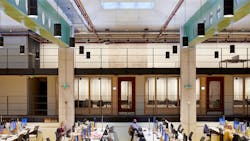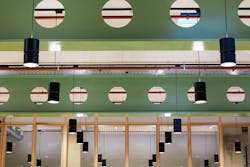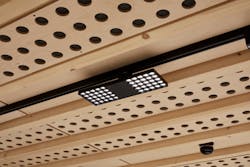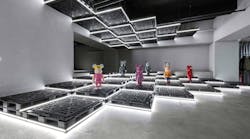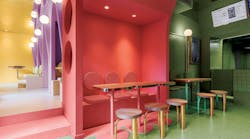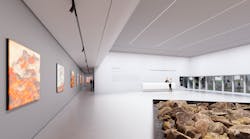Challenge: White Collar Factory may be one of London’s most pioneering new office developments, but its basement was never intended to become a workspace. However, when plans to turn this underground area into a restaurant failed to materialize, the building’s architects, Allford Hall Monaghan Morris (AHMM), saw an opportunity. The space, after all, had some unique features, such as a 26-ft. floor-to-ceiling height, which created the feeling of a grand hall. This was enough to convince AHMM principal Simon Allford that the space could become an extra studio for the practice’s growing team. There was one problem—too little daylight. Luckily, there were lighting solutions available to bring the feeling of natural light beyond the natural reach of the sun.
Solution: ERCO’s human-centric lighting system plays an important role in bringing natural variation to the workspace over the course of a day. In fact, its Atrium Double Focus pendants help support the circadian rhythm with dimming capability, tunable white light, and glare control. These can-shaped pendants bring the high ceilings into the lighting scheme, casting illumination both up and down. They are supported by Jilly track downlights in the single-story spaces, which use wide and oval beam distributions to place light directly where it is needed, increasing visual comfort in the work environment. Pantrac track lights illuminate walls to make the space feel more open. This increases the perceived brightness of rooms since humans’ perception is stimulated more by illumination on vertical surfaces rather than by light on a horizontal plane.
“It is this idea that you are not looking at holes in the ceiling; you are looking at sources of light landing on surfaces,” Allford explains.
A Flexible Work Environment
The changing nature of today’s workplace, particularly in light of COVID-19, meant that flexibility had to be built into the interior from the outset. One way AHMM achieved this was via “Jack,” a modular system consisting of box-like plywood cassettes. The Jack system makes it possible to create meeting rooms that can be taken down and reconfigured in a matter of hours. Here, this means that the office can be adapted as the size of the team grows or shrinks.
The lighting design supports this need for flexibility. On the one hand, with the Casambi Bluetooth control system, luminaires can be easily programmed to suit new layouts. Additionally, the track downlights can be physically rearranged with ease. Each desk is also equipped with its own Lucy task light, giving employees more control over their immediate environment. “It is about personality and character,” says Allford. “You can move a wall, move a light, or you can change your light source, so people can remake their environment depending on their mood.”
This article appeared in the March 2022 issue of Architectural SSL magazine.
